Exploring the depths of Lake Titicaca for signs of the lost city of Wanaku.
Exploring the Depths of Lake Titicaca for Signs of the Lost City of Wanaku
Lake Titicaca, situated between Bolivia and Peru, is renowned as the highest navigable lake in the world, perched at an altitude of approximately 3,812 meters (12,507 feet) above sea level. This expansive lake, surrounded by the stunning Andes mountain range, holds not only ecological and cultural significance, but also whispered legends of ancient civilizations, particularly that of the storied Wanaku–often referred to as the lost city.
The Legend of Wanaku
Wanaku, believed to have been a flourishing center of culture and trade, was associated with the Aymara and Inca civilizations. Historical records indicate that the city might have thrived from around the 7th century to the 12th century AD, significantly contributing to the regional economy through agriculture and artisanal crafts. But, like many ancient cities, it reportedly vanished, leaving only fragments of folklore and speculation about its location and fate.
Archaeological Context
Archaeological efforts have aimed to trace the history of Lake Titicaca and its surrounding areas. Research has uncovered various archaeological sites, such as the ruins of Tiwanaku, located just south of the lake. Tiwanaku is recognized as one of the most important pre-Columbian archaeological sites in South America, believed to have been a major urban center before it fell into decline.
The search for Wanaku is driven by a combination of historical texts and local myths. Some researchers maintain that the city is submerged beneath the waters of Lake Titicaca, while others speculate that it may lie hidden in the nearby hills.
Recent Expeditions and Technology
In recent years, advancements in technology have reignited interest in the quest for Wanaku. Submersible drones equipped with sonar technology and underwater cameras have enabled researchers to explore the depths of Lake Titicaca more thoroughly than ever before. These expeditions aim to identify submerged structures and artifacts that could provide concrete evidence of Wanaku’s existence.
- In 2021, a research team conducted an exploratory mission using multi-beam sonar technology, revealing unusual formations thought to be remnants of ancient man-made structures.
- Plus, a 2023 expedition employed underwater robotics to capture high-definition images of the lakebed, leading to the discovery of ceramic pieces and stone tools, which suggest human habitation.
The application of technologies like geographic information systems (GIS) and 3D modelling continues to enhance our understanding of the ancient landscape, guiding researchers to potential sites where Wanaku may be located.
Environmental Considerations
While the search for Wanaku is thrilling, it is imperative to approach it with respect to the ecological and cultural preservation of Lake Titicaca. lake is particularly sensitive due to its unique biodiversity, including several endemic fish species. The local communities heavily depend on these resources for their livelihoods. Balancing archaeological endeavors with environmental stewardship is critical.
Future Directions and Implications
The quest for Wanaku not only holds the potential for archaeological discovery but also serves as an opportunity for cultural revitalization. Discovering remnants of this ancient civilization could enhance the understanding of the pre-Columbian history of the Andes and provide insights into the socio-economic structures of the time.
Also, this exploration fosters tourism, encouraging a deeper appreciation for local heritage among visitors, which can economically benefit surrounding communities. Educating tourists about the importance of protecting natural and archaeological sites can lead to sustainable tourism practices.
Actionable Takeaways
- Stay informed about ongoing research and expeditions through reputable archaeological journals and local news.
- Support organizations dedicated to cultural preservation and responsible tourism in the Lake Titicaca region.
- If visiting Lake Titicaca, engage with local operators that promote eco-friendly tours and initiatives.
The search for Wanaku remains a captivating intersection of myth, history, and science. As technology progresses and research continues, the possibility of uncovering the lost city becomes increasingly tangible, bringing with it the promise of new insights into the rich tapestry of human civilization.


